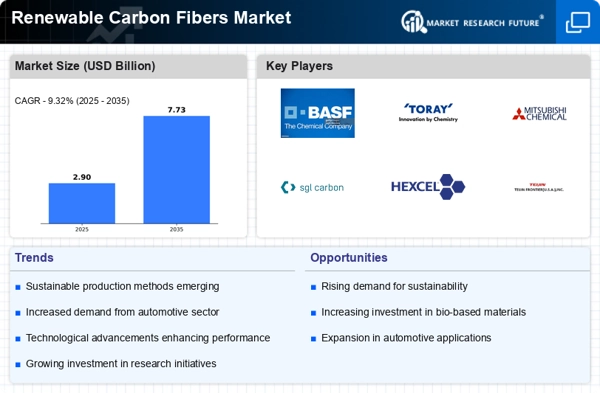Supportive Regulatory Frameworks
The Renewable Carbon Fibers Market benefits from a supportive regulatory environment that encourages the adoption of sustainable materials. Governments across various regions are implementing policies and incentives aimed at promoting the use of renewable resources and reducing reliance on fossil fuels. For example, regulations mandating the use of sustainable materials in construction and transportation sectors are driving demand for renewable carbon fibers. Additionally, funding programs and grants for research into sustainable technologies are further bolstering the market. As a result, the renewable carbon fibers sector is likely to see increased investment and growth opportunities, with market projections indicating a potential increase in market size by 15% over the next few years due to favorable regulatory conditions.
Growing Applications in Diverse Industries
The versatility of renewable carbon fibers is contributing to their expanding applications across various industries, thereby driving the Renewable Carbon Fibers Market. These fibers are increasingly utilized in sectors such as automotive, aerospace, construction, and sports equipment, where their lightweight and high-strength properties are highly valued. For instance, the automotive industry is adopting renewable carbon fibers to enhance fuel efficiency and reduce emissions, aligning with sustainability goals. Market data suggests that the automotive sector alone could account for over 25% of the total demand for renewable carbon fibers by 2030. This diversification of applications not only broadens the market base but also encourages innovation in fiber development, further solidifying the position of renewable carbon fibers in the materials market.
Increasing Demand for Sustainable Materials
The Renewable Carbon Fibers Market is experiencing a notable surge in demand for sustainable materials, driven by heightened consumer awareness regarding environmental issues. As industries seek to reduce their carbon footprints, renewable carbon fibers present a viable alternative to traditional materials. This shift is reflected in the growing adoption of renewable carbon fibers in sectors such as automotive and aerospace, where lightweight and strong materials are essential. Market data indicates that the demand for sustainable materials is projected to grow at a compound annual growth rate (CAGR) of approximately 12% over the next five years, underscoring the potential for renewable carbon fibers to capture a significant share of the market. Companies are increasingly investing in research and development to enhance the properties of these fibers, further propelling their adoption across various applications.
Consumer Preference for Eco-Friendly Products
Consumer preferences are shifting towards eco-friendly products, significantly impacting the Renewable Carbon Fibers Market. As awareness of environmental issues grows, consumers are increasingly seeking products that align with their values, prompting manufacturers to incorporate renewable carbon fibers into their offerings. This trend is particularly evident in the fashion and textile industries, where brands are adopting sustainable materials to appeal to environmentally conscious consumers. Market Research Future indicates that approximately 70% of consumers are willing to pay a premium for products made from sustainable materials, highlighting the lucrative opportunities for companies in the renewable carbon fibers sector. This consumer-driven demand is likely to propel the growth of the market, as businesses strive to meet the expectations of their clientele while contributing to sustainability efforts.
Technological Innovations in Fiber Production
Technological advancements play a pivotal role in shaping the Renewable Carbon Fibers Market. Innovations in production techniques, such as the development of bio-based precursors and advanced processing methods, are enhancing the performance and cost-effectiveness of renewable carbon fibers. For instance, recent breakthroughs in the conversion of biomass into high-quality carbon fibers have the potential to lower production costs significantly. Market analysis suggests that these innovations could lead to a reduction in production costs by up to 30%, making renewable carbon fibers more competitive against conventional materials. Furthermore, the integration of automation and digital technologies in manufacturing processes is expected to streamline operations, improve efficiency, and increase output, thereby fostering growth in the renewable carbon fibers sector.

















Leave a Comment